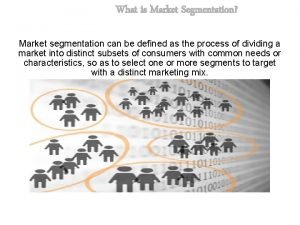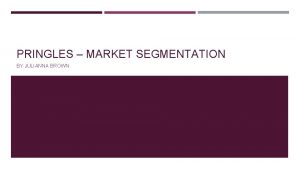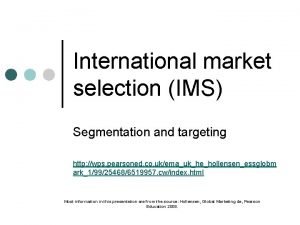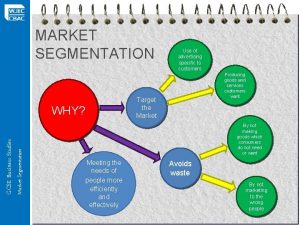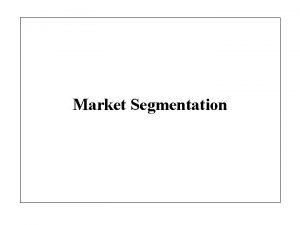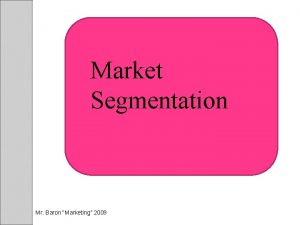CHAPTER 5 MARKET SEGMENTATION 10312020 1 Market Segmentation

















- Slides: 17

CHAPTER 5 MARKET SEGMENTATION 10/31/2020 1

Market Segmentation Market is where the product sold and profit is generated, and consists of all the potential group of customers sharing needs and wants. n To understand the market, marketers must understand the customers, and marketing research is an effective tool in this process. n Channels play important role in segmentation decision. n 10/31/2020 2

Market Boundaries Market can be defined by the following factors: n Product and service category: actual product n Geography: location of seller n Physical customer groupings: suppliers in industrial market n Intangibles: price as a differentiation factor 10/31/2020 3

Market Boundaries (Cont. ) Customers: Current buyers as well as those who have switched. n Users: End users rather than purchasers n Prospects: potential customers. n Penetration: percentage of users. n Brand share: sales of a brand in a particular market n The pareto, 80: 20 effect n 10/31/2020 4

Market Segmentation By use: 1. occasional, 2. benefits, 3. loyalty 4. frequency n By price and quality n By consumer characteristics: 1. geographic, 2. demographic, 3. socio-economic(income, social class), 4. life styles(culture). n By product benefit n 10/31/2020 5

Market Segmentation (Cont. ) Segmentation across national boundariesset of socio-economic, political and cultural criteria. n Market segmentation is dividing market into groups of similar characteristics, and selecting the most appropriate group(s) to serve n 10/31/2020 6

A Model of Market Segmentation Process n Delineate firm’s current situation » opportunities, resources, objectives and constraints n Determine customers needs and wants » Marketing research is used for this purpose n Divide market on relevant dimensions » A prior or post hoc segmentation n segmentation decision before and after market research » Relevance of segmentation Dimensions n n managers’ expertise and experience play an important role All variables should be included in segmentation 10/31/2020 7

A Model of Market Segmentation Process (cont. ) » Basis for segmentation n n Benefit sought – attempts to measure consumers’ value system. It is a market-oriented approach that seeks to identify consumer needs and wants to develop product and satisfy the desired benefits. Psychographic segmentation – VALS 2 model: values and life styles. Vertical dimensions represent resources such as income, education, health and intelligence, the horizontal dimensions are self-orientations such as principle, action and self orientations. They represent 9 to 17 percent of the US adult population. 10/31/2020 8

» Basis for segmentation (cont. ) n Psychographic segmentation (cont. ) – VALS 2: (1)Principle oriented consumer-guided by their views of how the world is, or should be (2)Status oriented consumers-guided by the action and opinion of others (3)Action oriented consumers-guided by a desire for social or physical activity, variety and risk taking 10/31/2020 9

VALS 2 Model 10/31/2020 10

A Model of Market Segmentation (cont. ) Develop product positioning n Decide segmentation strategy n » Measurable » Meaningful-large enough » Marketable-reachable n Design marketing mix strategy 10/31/2020 11

Segmentation Methods Background investigation: hypotheses about which segments are viable n Qualitative research: focus group n Quantitative research: n Analysis: discriminant analysis, factor analysis, cluster analysis n Segmentation/positioning: positioning map. n 10/31/2020 12

Product/Service Positioning Homogeneous n Diffuse n Clustered n Positioning/Perceptual maps n » graphic indication of firm’s product against to competitors. n It shows: – competitors which are closer to your product – positioning gap – a sound base for re-positioning. 10/31/2020 13

Positioning Process Market segmentation n Target marketing n Product positioning n segmentation targeting 10/31/2020 positioning 14

Possible Approaches to Segmentation n Single segment » concentration and specialization(niche market) n Multiple segment » one or more product, two or more segments. n Cross segment » same product for different segment n Full coverage » undifferentiated(coca cola) » differentiated(IBM). 10/31/2020 15

Branding and Policies Product differentiation n Effect consumers’ perception n Brand monopoly n » trademarks, registration n Branding policies » company name » family branding » individual branding 10/31/2020 16

Branding and Policies (Cont. ) n Brand extension » a strong brand name can be used for a new product(Diet Coke) n Multibrand » one company, several brands. n Co-branding » two different brands from two different companies may be team up. n Private and generic brand 10/31/2020 17
 Segmentation targeting positioning
Segmentation targeting positioning Market leader market challenger market follower
Market leader market challenger market follower Geographic segmentation of cadbury
Geographic segmentation of cadbury Market mapping template
Market mapping template Kfc segmentation targeting positioning
Kfc segmentation targeting positioning Marketing strategy segmentation targeting positioning
Marketing strategy segmentation targeting positioning Nivea segmentation
Nivea segmentation Requisites of sound marketing segmentation
Requisites of sound marketing segmentation Pringles brown
Pringles brown Bases of market segmentation
Bases of market segmentation Health insurance market segmentation
Health insurance market segmentation Demographic geographic psychographic market segmentation
Demographic geographic psychographic market segmentation Segmentation targeting and positioning of nestle
Segmentation targeting and positioning of nestle Fine grained screening
Fine grained screening Nike segmentation
Nike segmentation What is global market segmentation
What is global market segmentation Market segmentation matrix
Market segmentation matrix Customer classification matrix
Customer classification matrix


